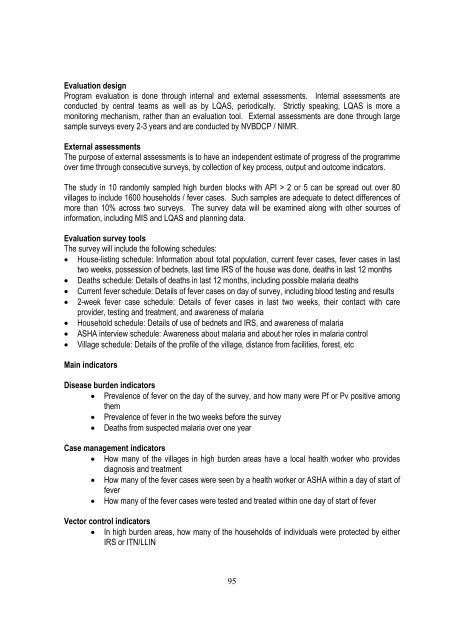training module for medical officers primary health centre - NVBDCP
training module for medical officers primary health centre - NVBDCP
training module for medical officers primary health centre - NVBDCP
- No tags were found...
You also want an ePaper? Increase the reach of your titles
YUMPU automatically turns print PDFs into web optimized ePapers that Google loves.
Evaluation designProgram evaluation is done through internal and external assessments. Internal assessments areconducted by central teams as well as by LQAS, periodically. Strictly speaking, LQAS is more amonitoring mechanism, rather than an evaluation tool. External assessments are done through largesample surveys every 2-3 years and are conducted by <strong>NVBDCP</strong> / NIMR.External assessmentsThe purpose of external assessments is to have an independent estimate of progress of the programmeover time through consecutive surveys, by collection of key process, output and outcome indicators.The study in 10 randomly sampled high burden blocks with API > 2 or 5 can be spread out over 80villages to include 1600 households / fever cases. Such samples are adequate to detect differences ofmore than 10% across two surveys. The survey data will be examined along with other sources ofin<strong>for</strong>mation, including MIS and LQAS and planning data.Evaluation survey toolsThe survey will include the following schedules: House-listing schedule: In<strong>for</strong>mation about total population, current fever cases, fever cases in lasttwo weeks, possession of bednets, last time IRS of the house was done, deaths in last 12 months Deaths schedule: Details of deaths in last 12 months, including possible malaria deaths Current fever schedule: Details of fever cases on day of survey, including blood testing and results 2-week fever case schedule: Details of fever cases in last two weeks, their contact with careprovider, testing and treatment, and awareness of malaria Household schedule: Details of use of bednets and IRS, and awareness of malaria ASHA interview schedule: Awareness about malaria and about her roles in malaria control Village schedule: Details of the profile of the village, distance from facilities, <strong>for</strong>est, etcMain indicatorsDisease burden indicators Prevalence of fever on the day of the survey, and how many were Pf or Pv positive amongthem Prevalence of fever in the two weeks be<strong>for</strong>e the survey Deaths from suspected malaria over one yearCase management indicators How many of the villages in high burden areas have a local <strong>health</strong> worker who providesdiagnosis and treatment How many of the fever cases were seen by a <strong>health</strong> worker or ASHA within a day of start offever How many of the fever cases were tested and treated within one day of start of feverVector control indicators In high burden areas, how many of the households of individuals were protected by eitherIRS or ITN/LLIN95
















